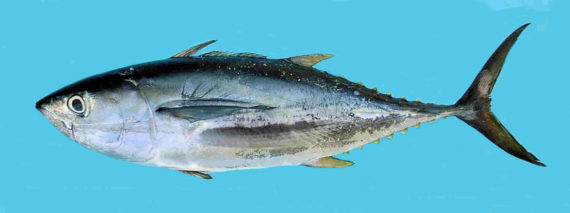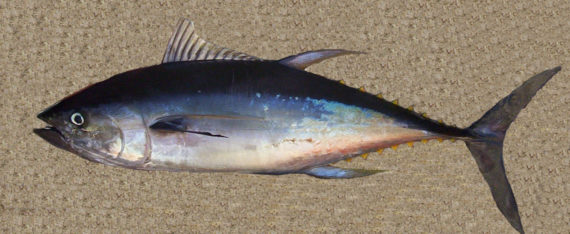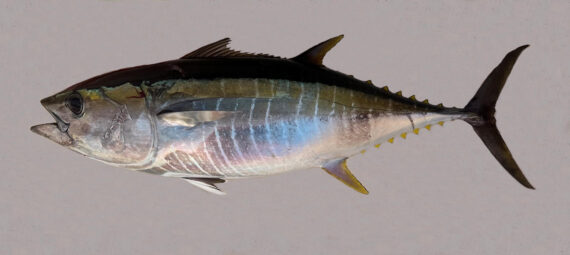Yellowfin Tuna, Thunnus albacares
 Yellowfin Tuna, Thunnus albacares. Fish provided by the commercial fishermen of the greater Los Cabos area, Baja California Sur, September 2014. Length: 51 cm (20 inches).
Yellowfin Tuna, Thunnus albacares. Fish provided by the commercial fishermen of the greater Los Cabos area, Baja California Sur, September 2014. Length: 51 cm (20 inches).
 Yellowfin Tuna, Thunnus albacares. Fish caught from coastal waters off Puerto Los Cabos, Baja California Sur, August 2006. Length: 1.24 meters (4 feet 1 inches).
Yellowfin Tuna, Thunnus albacares. Fish caught from coastal waters off Puerto Los Cabos, Baja California Sur, August 2006. Length: 1.24 meters (4 feet 1 inches).
 Yellowfin Tuna, Thunnus albacares. Fish caught from coastal waters off Point Palmilla, Baja California Sur, en route to the family dinner table. An interesting and somewhat common sight on THE main roads of Los Cabos when Yellowfin come to town for holidays.
Yellowfin Tuna, Thunnus albacares. Fish caught from coastal waters off Point Palmilla, Baja California Sur, en route to the family dinner table. An interesting and somewhat common sight on THE main roads of Los Cabos when Yellowfin come to town for holidays.
 Yellowfin Tuna, Thunnus albacares. Fish caught from coastal waters off San Diego, California, November 2016. Length: 1.02 m (3 feet 4 inches). Catch, photograph and identification courtesy of Chris Wheaton, Fullerton, California.
Yellowfin Tuna, Thunnus albacares. Fish caught from coastal waters off San Diego, California, November 2016. Length: 1.02 m (3 feet 4 inches). Catch, photograph and identification courtesy of Chris Wheaton, Fullerton, California.
 Yellowfin Tuna, Thunnus albacares. Fish caught from coastal waters off Loreto, Baja California Sur, November 2023. Length: 1.09 m (3 feet 7 inches). Catch, photograph and identification courtesy of Chris Wheaton, Fullerton, California.
Yellowfin Tuna, Thunnus albacares. Fish caught from coastal waters off Loreto, Baja California Sur, November 2023. Length: 1.09 m (3 feet 7 inches). Catch, photograph and identification courtesy of Chris Wheaton, Fullerton, California.
 Yellowfin Tuna, Thunnus albacares. Fish caught from coastal waters within Bahia Solano, Colombia, June 2019. Length: 1.32 m (4 feet 4 inches). Weight: 45 kg (100 lbs). Catch, photograph and identification courtesy of Chris Wheaton, Fullerton, California.
Yellowfin Tuna, Thunnus albacares. Fish caught from coastal waters within Bahia Solano, Colombia, June 2019. Length: 1.32 m (4 feet 4 inches). Weight: 45 kg (100 lbs). Catch, photograph and identification courtesy of Chris Wheaton, Fullerton, California.
 Yellowfin Tuna, Thunnus albacares. Two icons within the fishing community of Palmilla Beach, my good friends Polo and Captain Pablo Pino B, and their 101 kg (223 lbs) ATÚN caught out of a Panga in coastal waters of the greater Los Cabos area, Baja California Sur, July 2013.
Yellowfin Tuna, Thunnus albacares. Two icons within the fishing community of Palmilla Beach, my good friends Polo and Captain Pablo Pino B, and their 101 kg (223 lbs) ATÚN caught out of a Panga in coastal waters of the greater Los Cabos area, Baja California Sur, July 2013.
The Yellowfin Tuna, Thunnus albacares, is a member of the Mackerel or Scombridae Family, that is known in Mexico as atún aleta amarilla or simply ATÚN! Globally, there are eight species in the genus Thunnus, of which six are found in Mexican waters, two in the Atlantic, one in the Pacific, and three in both the Atlantic and the Pacific Oceans.
The Yellowfin Tuna has an elongated, rounded, fusiform, large “tuna-like” body that are deepest under the first dorsal fin and are aerodynamically designed for speed. Their body is a very dark metallic blue and transitions to silvery ventrally with about 20 vertical lines and a golden stripe along the sides. Their anal fin, second dorsal fin, and finlets are bright yellow (after which they are named) with a narrow black border. With age their anal and second dorsal fins become elongated and reach as far back as their caudal fin. Their head has small eyes and a small mouth that ends before the eyes and is equipped with small conical teeth. Their anal fin has 11 to 16 rays followed by 7 to 10 finlets; their caudal fin is deeply forked with 2 small keels separated by 1 large keel at the base; their first dorsal fin has 11 to 14 spines; their second dorsal fin is set close to the first and has 12 or 16 rays followed by 7 to 10 finlets; and, their pectoral fins are moderately long, usually reaching beyond the second dorsal fin origin. They have 26 to 34 gill rakers on their first arch. They have a band of large scales forming a circle around the body behind their head.
The Yellowfin Tuna is a global pelagic species found worldwide in tropical and subtropical waters from latitudes of approximately 40°N to 35°S and in water temperatures between 18oC (65oF) and 31oC (88oF). They are normally found in the mixed surface layer of the ocean above the thermocline. They seldom go below depths of 100 m (330 feet) as they are sensitive to low concentrations of oxygen but have been documented at depths up to 1,160 m (3,810 feet). They are among the largest tuna species reaching a maximum (fork length) of 2.06 m (6 feet 9 inches) in length and 200 kg (440 lbs) in weight. As of January 1, 2024, the International Game Fish Association world record stood at 194 kg (427 lbs) with the fish caught in coastal waters off Cabo San Lucas, Baja California Sur in September 2012. I have included a Weight from Length Conversion Table for the Yellowfin Tuna to allow the determination, with good accuracy, of the weight of a fish from its fork length and hopefully to promote its rapid and unharmed return to the ocean. The Yellowfin Tuna are significantly smaller than the Atlantic Bluefin and Pacific Bluefin Tuna and slightly smaller than the Bigeye Tuna and the Southern Bluefin Tuna. They are known to regulate their body temperatures to levels above that of their environment. They are highly migratory and travel in large schools of similarly-sized fish that include Bigeye Tuna, Skipjack Tuna, other tuna, dolphins, and large marine animals such as whales and Whale Sharks. They are known to collect in and around drifting objects such as driftwood, patches of seagrass, boats, and dead marine animals. They are mainly an offshore species but will approach the shore in pursuit of small bait fish when the water is clear and food is abundant. They are opportunistic predators preying on fish (Anchovies, Bullet Mackerel, Flying Fish, Frigate Mackerel, Sardines, Sauries, and Skipjack Tuna), pelagic crustaceans, and squid and operate in a highly competitive quest for food. They are preyed upon by several sharks, including the Bignose Shark, Carcharhinus altimus, the Blacktip Shark, Carcharhinus limbatus, and the Cookiecutter Shark, Isistius brasiliensis, seabirds, and predatory fish such as billfish, sharks, Wahoo, and whales. They have the ability to escape many predators due to their swimming speeds that can reach 50 mph and their strong endurance. Reproduction is oviparous and occurs in batches with each female releasing between 165,000 and 8,000,000 eggs annually; larger fish produce more eggs than smaller fish. Fertilization is external with eggs and larvae being pelagic. Juveniles grow quickly and average 3.4 kg (7.5 lbs) in eighteen months and 63.5 kg (140 lbs) in four years. Their lifespans vary by location and ranges from five to eight years.
The Yellowfin Tuna is similar in appearance to several other tuna species including the Albacore, Thunnus alalunga (25 to 31 gill rakers; long pectoral fins extending past anal and dorsal fin lobes; narrow white margin on caudal fin), the Bigeye Tuna, Thunnus obesus (25 to 29 gill rakers), and the Blackfin Tuna, Thunnus atlanticus (19 to 25 gill rakers; dusky bronze finlets).
The Yellowfin Tuna is a resident of all Mexican waters of the Atlantic and the Pacific Oceans with the exception that they are absent from the extreme northern portions of the Sea of Cortez.
From a conservation perspective the Yellowfin Tuna is currently considered to be Near Threatened. Although that have a wide global distribution, are relatively abundant, fast growing, and very fecund, their harvest levels are greater than sustainable levels. In 2004, conservation measures were imposed in certain areas of the world that included catch quotas and area closures in an effort to maintain stock at average Maximum Sustainable Yield levels. Today, in many global areas the Yellowfin Tuna fishery is considered Fully Exploited to Over Exploited. A decline in the quantity and size of fish caught have been a recent trend. The main cause for these declines is attributed to the commercial tuna fisheries. Efforts to raise Yellowfin Tuna by aquaculture from eggs of hatchery-raised fish is in its infancy has been plagued with problems.
The Yellowfin Tuna is heavily fished commercially on a large global scale and caught with purse seines and longlines. They are the second most important tuna species for canning. The days of the often photographed commercial catch by pole and line are gone. Purse seine vessels use on-board lookouts, sophisticated on-board electronics, sea surface temperature and other satellite data, and helicopters to locate Yellowfin Tuna. They are then netted with catches from a single school approaching 100 tons. The Eastern Pacific has a high level of fishing pressure from about 300 boats from 16 different countries fishing for Yellowfin Tuna. Global annual catch rates are approximately 1,500,000 tons, of which 150,000 tons are caught in Mexican waters. This approach is highly controversial however due to the by-catch kill of various species of dolphins. In 2010, Greenpeace International added Yellowfin Tuna to the seafood red list, i.e. fish commonly sold around the world with a high risk of being sourced from unsustainable fisheries. Other commercial approaches have been tried but are plagued with large numbers of small juvenile Yellowfin Tuna, billfish, manta rays, sea birds, sea turtles, and sharks as by-catch. Most of the commercial catch is canned, but the highest quality fish are sold for sashimi, most of which are provided by longline fishermen. They are also important to the smaller scale artisanal fisheries that supply local people with basic food. They are also pursued heavily on a global basis by sportsfishermen, as they are prized for their speed, strength, and stamina as well as food value.